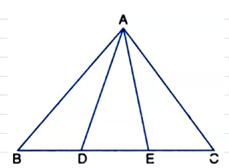Let A and B be two sets such that n(A)=3 and n(B)=2.if (x,1), (y,2), (z,1)are ∈ A×B, find A and B, where x,y,z are distinct elements.
The correct Answer is:N/a
Here (x,1),(y,2),(z−1)∈A×B
⇒x,y,z∈Aand1,2∈B
⇒A={x,y,z}andB={1,2}
Topper's Solved these Questions
- BOOK - NAGEEN PRAKASHANCHAPTER - RELATIONS AND FUNCTIONSEXERCISE - Exercise 2.29videos
RELATIONS AND FUNCTIONS
- BOOK - NAGEEN PRAKASHANCHAPTER - RELATIONS AND FUNCTIONSEXERCISE - Exercise 2.35videos
RELATIONS AND FUNCTIONS
- BOOK - NAGEEN PRAKASHANCHAPTER - RELATIONS AND FUNCTIONSEXERCISE - Exercise 2 G10videos
RELATIONS AND FUNCTIONS
- BOOK - NAGEEN PRAKASHANCHAPTER - PROBABILITYEXERCISE - MISCELLANEOUS EXERCISE10videos
PROBABILITY
- BOOK - NAGEEN PRAKASHANCHAPTER - SEQUENCE AND SERIESEXERCISE - Miscellaneous Exercise32videos
SEQUENCE AND SERIES
Similar Questions
Let A and B be two sets such that n(A)=3 and n(B)=2. If (x,1), (y,2), (z,1) are in A×B, write A and B.
View SolutionLet A and B be two sets such that n(A)=3andn(B)=2. If (x,1),(y,2),(z,1)are in A ×B. find A and B. where x, y and z are distinct elements.
View SolutionLet A and B be two sets such that n(A)=3 and n(B)=2.
If a≠b≠c and (a,0),(b,1),(c,0) are in A×B, find A and B.View SolutionLet A and B be two sets such that n(A)=5 and n(B)=2, if a, b, c, d, e are distinct and (a,2), (b,3), (c,2), (d,3), (e,2) are in A×B , find A and B.
View SolutionIf n is a whole number such that n+n=n, then n=? (a) 1 (b) 2 (c) 3 (d) none of these
View SolutionThe set A and B has 3 common elements . If n(A) =5 and n(B)=4, then find n(A×B) and x{(A×B)∩(B×A)}
View SolutionLet AandB b e two independent events. Statement 1: If (A)=0.3andP(A∪¯¯¯B)=0.8,thenP(B) is 2/7. Statement 2: P(E)=1−P(E),whereE is any event.
View SolutionA, B, C are three sets of values of x: A:2, 3, 7, 1, 3, 2, 3, B:7, 5, 9, 12, 5, 3, 8 C:4, 4, 11, 7, 2, 3, 4 Which one of the following statements is correct? Mean of A= Mode of C Mean of C=Median of B Median of B=Mode of A Mean, Median and Mode of A are equal
View SolutionIn Figure DandE are two points on BC such that BD=DE=EC Show that ar(ABD)=ar(ADE)=ar(AEC)
 View Solution
View SolutionIf S is the sample space and P(A)=13P(B) and S=A∪B ,where A and B are two mutually exclusive events then P(A)=
View Solution

